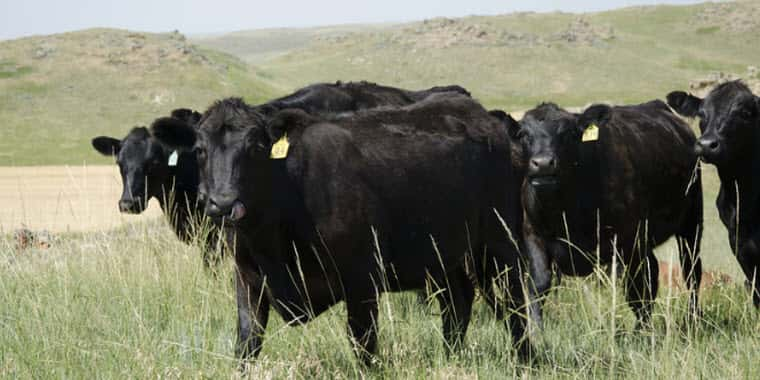Beef cows have been getting bigger over the last several decades according to data from the United States Beef Improvement Federation and the National Cattle Slaughter Summary. In 1975, the average US beef cow weighed 1,047 pounds but in 2009 weighed 1,350 pounds – an increase of 303 pounds on average across almost four decades! American Cattleman also estimate that 16 percent of the U.S. beef cow herd consisted of cows weighing over 1,500 pounds in 2010 or more than 5 million cows.
The drivers of this trend towards larger cattle can be attributed to the advancement of genetic information to assist ranchers in selecting productive animals. The use of growth-based genetics through Expected Progeny Difference (EPD) data has helped ranchers select bulls that produce growthy calves that have higher weaning weights.
This is not necessarily a bad thing for a terminal bull that is only producing calves going into a terminal feeding scenario, however, it is common for many heifers to be retained back and put out on the range. Unfortunately, there is also a relationship between the selection for muscle growth (i.e., production traits) and increasing maternal traits such as maternal weight, maternal height and maternal milk. These maternal traits indicate what you might expect out of a bull’s daughters. Not only will a growthy bull’s daughters be larger, but they likely will produce more milk.
In contrast to the increase in cow size and selection for growth, evidence suggests that calf weaning weights may no longer be increasing in the northern U.S. states (Colorado, Iowa, Minnesota, Montana, Nebraska, North Dakota, South Dakota, Wisconsin and Wyoming) based on an analysis of forecasted delivery weight of calves offered for sale through Superior Livestock Auction’s video sales from 1995 to 2016.
Impacts on the Beef Industry
Larger cattle can have an impact at all segments of the beef industry – from transport, to processing, to retail. Cattle can bump and bruise their backs as they go into the lower deck during transportation. This can cause bruising in the strip loin and require a carcass cutout. Today, it is estimated $35 million is lost annually due to an estimate of 68 percent of carcasses having bumps and bruises.
Carcasses that are too large at the processing stage may also be problematic because the rail-to-floor height may not be able to accommodate cattle over 58 inches tall. Carcasses of this size run the risk of dragging on the floor at plants.
Finally, at the retail stage of the beef industry, larger carcasses result in larger primal cuts which may have negative consequences for consumers. Recent reports suggest that primal cuts are too big and retailers are forced to cut steaks smaller to meet packaging and cost restrictions.
Implications for Grazing Wyoming Rangelands
Although beef genetics have rapidly advanced, forage production on rangelands has not appreciably increased during that same time frame. Predictions for increasing frequency and magnitudes of drought could reduce rangeland forage in some areas.
Ultimately, larger cows that produce more milk require more forage for maintenance. As cow size increases, forage intake requirements also increase proportionally because larger cows have a larger rumen, larger proportion of body mass comprised of visceral organs and greater nutritional maintenance requirements.
Smaller cows have been shown to be more efficient because they have lower maintenance requirements. Smaller cows also have the potential to be more efficient calf producers because their calves gain more weight in relation to dam weight when compared to larger cows. Larger sized cattle translates into eating more to maintain adequate body condition. However, it is important to note that selecting for increased fertility may be more important than selection purely based on cow size.
Conclusions
Many herds would be well served to purchase replacement females with desirable maternal characteristics and focus breeding decisions on terminal progeny. Trying to balance selection for maternal and terminal traits has contributed to this situation.
If a producer chooses to retain their own heifers rather than purchasing replacement heifers, it is critical to not only consider the production trait EPD’s of sires like birth weight, calving ease, weaning weight and yearling weight, but to also look at maternal trait EPD’s such as maternal milk, maternal height and maternal weight when considering purchasing bulls that will sire your replacement heifers. These maternal traits are all indications of what that bull’s daughters will be like. The beef industry is aware of this cow size, milk and nutrient requirement trend and is making additional selection indices available.
More small to moderate size cows can be economically advantageous because overhead costs can be spread over more animals and more cows equal more calves that could potentially result in greater total pounds weaned. Because rangeland forage grazed by roaming cattle is often the most economical nutrient source, matching cow size to forage resources to optimize forage utilization should be integrated into the ranch management and stocking rate decisions.
When considering the information in this fact-sheet, it is important to consider an entire ranch inventory of feed sources, forages, genetics and marketing strategies.
For more details and to read the full study on the trends and economics of increasing cow size visit: www.wyoextension.org
This study was written and compiled by John Derek Scasta, Dallas Mount, Blake Hauptman and Tamarah Jorns – University of Wyoming Extension


